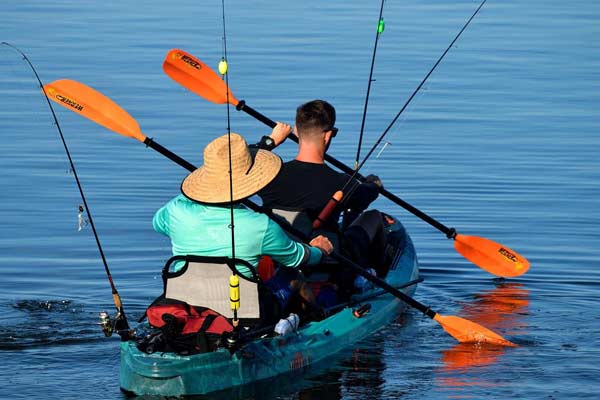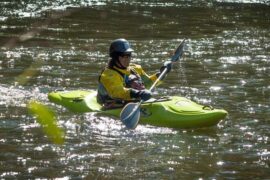Strategies for Getting In and Out of a Kayak Time Machine
Kayaking often feels like you’re stuffed inside a protective bubble, and runaway imaginations might liken the process to traveling in time.
Many of the best kayaking venues crisscross areas of rural charm and can appear as though you’ve arrived back in time when you exit. Getting in and out of your kayak proves challenging — especially when scanning for talking apes or dinosaurs.
Making a Graceful Entrance
Unfortunately, there’s no graceful way to get in or out of a kayak, so leave dignity at home. The simplest method for getting in and out of a kayak is grasping a friend’s hand for balance as you sit down in your pod.
Getting out requires putting your feet outside, straddling the kayak, and using the paddle for stability as you rise.
The question of entering and exiting a kayak might seem trivial, but it is the most common question newbies ask. If you’re alone when getting in, the above method won’t work for you, so consider the following foolproof strategies.
Different Approaches for Entering and Exiting a Kayak
Unfortunately, figuring out a safe way to enter or exit your kayak remains a concern even for experienced kayakers who might be facing old injuries.
These injuries might challenge your ability to move your knees, shoulders, and other joints freely. The following simple steps work exceptionally well for getting in and out of your kayak:
- Unload Your Kayak
Unload the kayak, and carry it to the water. Use a cart if necessary. - Arrange Your Kayak
Place the kayak in the water, and arrange it parallel to the shore, just deep enough to float. - Place a Paddle Across the Kayak
Place a paddle perpendicular across the kayak with one end supported by the beach. That provides a stable base from which to maintain your balance. - Stand Facing the Paddle and Front of the Kayak
Place your far leg in the kayak first while bracing yourself with the paddles. Pull the other leg inside, and sit down carefully.
You might feel that you’re plopping down dangerously fast, but the touchpoints prevent injuries and damage. Now you’re ready to go. Just follow the same steps in reverse to exit the kayak.
Special Situations
Many exceptional circumstances might limit your ability to get in and out of your kayak using standard methods. These include senior citizen kayaking and obese or handicapped kayakers.
Seniors can visit ADA-accessible docks for help with a specific type of handicap or general mobility help for canoeing, kayaking, and paddleboarding. These facilities offer such technology as wheelchair transfer platforms, adjustable launch platforms, and overhead and side-assist bars.
With an ADA-compliant gangway, handicapped, disabled, and older people can launch canoes and kayaks like pros. These advances provide equal opportunities for all, and most docks offer services to seniors at little or no cost.
Getting into a Kayak Without Tipping Over
Learning how to get into a kayak or other vessel is relatively easy without tipping it over. It just takes a little practice until you master the art. Accidentally tipping over on shore often proves harmless, but tipping over in the water or falling off the dock can generate dangerous consequences.
Most kayaks are stable, but you can learn how to enter and exit even unstable vessels by following these recommendations:
- Try to launch from a gently sloping, sandy area free of rocks and other detritus.
- Kayak with a buddy, and use their assistance to maintain balance.
- Use a stable log or rock to maintain your balance if no friend is available.
- The paddle was designed for stability and balance and not just for paddling.
- Try to go kayaking only on sunny, relatively windless days.
- Get seated as quickly as you can.
- Always wear a safety jacket with flotation capability when kayaking.
Staying Safe in Emergencies
Getting in and out of your kayak can become more challenging during emergencies because you might panic. Dropping into cold water suddenly generates dangers to your health and a significant shock to your system. The most important piece of advice is to stay calm and try not to panic. Other steps include:
- Initial Steps
Remember your options for getting back into your kayak. If possible, find someone to stabilize your kayak while you scramble aboard. If no help seems to be around, don’t be afraid or embarrassed to call out for help. - Keep Your Paddle
Your paddle can save your life by reaching out to the kayak and guiding it closer. Try to put the paddle close by while trying to get back inside. Your paddles can also be used to reach out to potential rescuers. - Right the Kayak
If your kayak turns over and begins taking on water, try to right it immediately. You might be able to push against the kayak to lift exactly it. You can also try to pull the kayak toward your body and use momentum to reach the hull. This method can prove difficult with heavier kayaks. If the kayak fills with water, you might need to return to shore to
Drain the water adequately.
Bug Out Box
Preparing for emergencies makes common sense for kayakers because they sometimes face unexpected dangers like escalating fetch wind speeds and waves. You should always include a standard first aid kit and the following items in your emergency kit:
- GPS or cellphone kept in a dry box protected against water intrusion
- Rain jacket or poncho
- Kayak source of light
- Emergency whistle
- Duct tape and electrical tape
Final Thoughts
Getting in or out of a kayak takes a little knowledge and practice. There’s not much to offer against wild daydreams like time travel, but those are the things that make kayaking so much fun.




